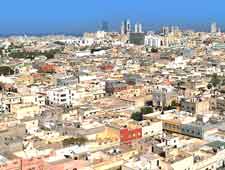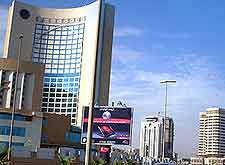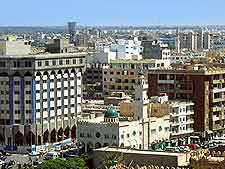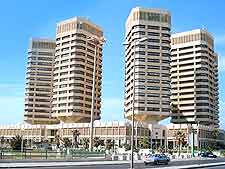Libya Capital City, About Tripoli Tourism and Travel
(Libya, LY, North Africa)

Whilst it has an undeniable cosmopolitan feel, Tripoli is still a fairly quiet place to visit during the daytime. In the early evening, however, the city starts to come to life as families and visitors take advantage of the cooler temperatures to enjoy its restaurants or simply take a stroll along the seafront.
Tripoli's architecture and atmosphere are something of a mixture of the Mediterranean and Arabic worlds that have helped to create the city we see today.

Tourism and General Information
It is thought that the city of Tripoli was originally founded in the 7th century BC by the Phoenicians. Since then, it has fallen under the control of many countries. Under the Romans, it became known as the Regio Tripolitana. When the Roman Empire finally came crashing down, Tripoli was invaded by the barbarian hordes and later the Byzantines. The Ottoman Turks,
Spain,
Italy and Britain have all briefly held power in the city. In 1951, Tripoli became the capital city of a newly independent Libya, along with Benghazi. However, since the 1970s, the city has enjoyed the status of being Libya's only capital.
Today, Tripoli is home to over one million people. Tripoli's 'Old Town', also known as the Medina, is on the site of the original ancient Phoenician city. The historic high walls date from Roman times, although most of the stone architecture seen within this neighbourhood actually sprang up in the 16th century.

Despite recent developments, this part of Tripoli has managed to retain much of its original charm. Today, the original wall still embraces the vast palace complex, as well as boasting numerous statues and fountains. Entrance to the Medina can be gained via any one of three gates, although the most popular one is situated by Green Square. The Medina's main street is the Sharia Jamaa ad-Draghut.
Tripoli also has a modern district, which grew up as a result of expansion that took place from the 18th century onwards. Populated mostly by high-rise buildings, there is little that stands out when it comes to architecture, although the promenade does give this district a definite seaside feel. The main commercial area leads off Green Square.
A third district, Tripoli Greens, is currently under development. Situated between Tripoli's international airport and the Old Town (Medina), this district will ultimately provide sustainable accommodation for Libya's government offices.

Tripoli has plenty of attractions to entertain visitors to the city. Popular sights include
Assaraya al-Hamra, also known as the Red Castle. As time goes by, more and more palaces are becoming accessible to tourists. The city also has a number of notable mosques. Close to the Gurgi Mosque is the Arch of Marcus Aurelius, Tripoli's only Roman remain. Energetic visitors might like to climb the city walls, which offer great panoramic views of the city.
Tripoli's souks and bazaars also provide a fascinating glimpse into life in the Libyan capital. The rich history of Tripoli and the surrounding area can be explored by visiting the city's museums, most notably the acclaimed
Jamahiriya Museum that is situated within the Red Castle.
 Whilst it has an undeniable cosmopolitan feel, Tripoli is still a fairly quiet place to visit during the daytime. In the early evening, however, the city starts to come to life as families and visitors take advantage of the cooler temperatures to enjoy its restaurants or simply take a stroll along the seafront.
Whilst it has an undeniable cosmopolitan feel, Tripoli is still a fairly quiet place to visit during the daytime. In the early evening, however, the city starts to come to life as families and visitors take advantage of the cooler temperatures to enjoy its restaurants or simply take a stroll along the seafront.
 Despite recent developments, this part of Tripoli has managed to retain much of its original charm. Today, the original wall still embraces the vast palace complex, as well as boasting numerous statues and fountains. Entrance to the Medina can be gained via any one of three gates, although the most popular one is situated by Green Square. The Medina's main street is the Sharia Jamaa ad-Draghut.
Despite recent developments, this part of Tripoli has managed to retain much of its original charm. Today, the original wall still embraces the vast palace complex, as well as boasting numerous statues and fountains. Entrance to the Medina can be gained via any one of three gates, although the most popular one is situated by Green Square. The Medina's main street is the Sharia Jamaa ad-Draghut. Tripoli has plenty of attractions to entertain visitors to the city. Popular sights include Assaraya al-Hamra, also known as the Red Castle. As time goes by, more and more palaces are becoming accessible to tourists. The city also has a number of notable mosques. Close to the Gurgi Mosque is the Arch of Marcus Aurelius, Tripoli's only Roman remain. Energetic visitors might like to climb the city walls, which offer great panoramic views of the city.
Tripoli has plenty of attractions to entertain visitors to the city. Popular sights include Assaraya al-Hamra, also known as the Red Castle. As time goes by, more and more palaces are becoming accessible to tourists. The city also has a number of notable mosques. Close to the Gurgi Mosque is the Arch of Marcus Aurelius, Tripoli's only Roman remain. Energetic visitors might like to climb the city walls, which offer great panoramic views of the city.